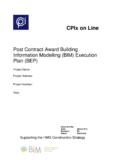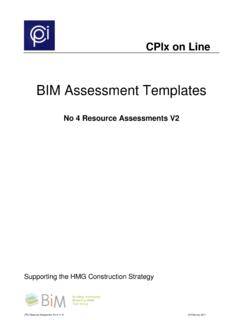Transcription of CLASSIFICATION - The Construction Project …
1 CLASSIFICATION . John Gelder Head of content development & sustainability, RIBAE. Manchester 31 January 2012. London 3 February 2012. 10:00-12:00. 1. CLASSIFICATION CONTEXT & ISO 12006-2 20. 2. Context: 25 years CAWS was published 25 years ago, Uniclass 15. Tension has been building Recessions Earthquakes CLASSIFICATION systems The longer the interval, the bigger the event! 3. CI/SfB. CI/SfB Construction indexing manual 1976. derived from Swedish SfB (Samarbetskomitt n f r Byggnadsfr gor), 1950, and UDC (Universal Decimal CLASSIFICATION ). First implemented in UK in 1961 as SfB/UDC Building filing manual Five tables: Table 0 Physical environment, 413 Hospitals mental, psychiatric Table 1 Elements, ( ) Walls, external walls loadbearing Table 2 Constructions, forms, F Brickwork, bricks Table 3 Materials, g2 Fired clay, vitrified clay, ceramics Table 4 Activities, requirements, (P3) Sound, quiet transfer Defunct but still in use, product literature (to BS 4940- 1-3:1994), NL/SfB.
2 4. Other precursors to Uniclass CAWS 1987 Common arrangement of work sections Some connections to CI/SfB Table 2, F Blockwork, brickwork But not, S Rigid tile work best treated as completely new CESMM3 (Civil Engineering Standard Method of Measurement) edition 3, ICE, 1991. EPIC (European Product Information Co-operation) . defunct also used for OmniClass Table 23. CIB Master List 1993 (Conseil International du B timent ..). (first published 1964). ISO TR 14177:1994 CLASSIFICATION of information in the Construction industry superseded by ISO 12006-2:2001. 5. Uniclass replacing CI/SfB. The SfB Agency in the UK decided (sometime before 1997).
3 That CI/SfB should be replaced by a unified CLASSIFICATION ' ( Uniclass) rather than revised: Widespread take-up of CAWS by NBS, SMM7 and NES. indicated that CI/SfB was not the preferred approach to CLASSIFICATION of work sections in the UK. CI/SfB did not reflect changes in the industry, new building types, new performance issues. CI/SfB notation (brackets, upper case and lower case, etc). is difficult to understand and computerise. Limitations of SfB in terms of computerisation led several countries to develop new approaches to CLASSIFICATION , so SfB was no longer being used internationally. 6. Legacy systems in Uniclass 1997.
4 Uniclass table Table code Sources Form of information A - Subject disciplines B - Management C London CLASSIFICATION of Business Studies and RIBA Plan of Work Facilities D CI/SfB Table 0. Construction entities E - Spaces F ISO 9836:1992 and RICS and ISVA. Code of measuring practice Elements Buildings G - Civil engineering works H - Work sections Buildings J CAWS. Civil engineering works K CESMM3. Construction products L EPIC. Construction aids M - Properties and characteristics N CIB Master List Materials P - Universal Decimal CLASSIFICATION Q UDC. 7. Revisions to Uniclass 1997. Table J revised 2008 for engineering services, following launch of NBS ES in 2004.
5 Uniclass Working Group established 2006. Elements for CAD layering & costing were first on the agenda always problematic quick fix Elements vs systems discussed later RIBAE/NBS commissioned by CPI to produce first tranche of unified' tables by Easter 2012. Work sections, elements, systems and products tables in draft more on this later Uniclass 2012 to be a dynamic CLASSIFICATION system Moderators needed 8. Non-Uniclass in the UK. BCIS & RICS elements classifications BCIS Standard form of cost analysis (SFCA) 2008, 5C3. Chemical and industrial waste disposal first edition 1961. RICS New rules of measurement (NRM) 1, 05 10 10.
6 Other transport systems NRM 2 & revised NRM 1 due in April 2012; NRM 3 due later in 2012 life cycle costing tools UK Standard Industrial CLASSIFICATION of Economic Activities (SIC 2007), 23320 Bricks made of clay The Town and Country Planning (Use Classes) Order 1987 Schedule, Class D2 Assembly and leisure 9. Some overseas classifications: 1. Aligned to ISO 12006-2:2001. Sweden: BSAB 96 current version 2005. Denmark: DBK 2006. Norway: NS 3451:2009 Table of building elements . first published 1988. North America: OmniClass 2011 legacy systems include: UniFormat (elements) Table 21. MasterFormat (work sections) Table 22 1995 edition replaced by 2004/2011.
7 EPIC (products) Table 23. Finland: Talo 2000 re-published 2010. New Zealand: CBI 2009 first published 1997. 10. Some overseas classifications: 2. WIPO Nice and Locarno Classifications UN International Standard Industrial CLASSIFICATION (ISIC Rev. 4), F410 Construction of buildings UN Standard Products and Services Code, 30131607 Clay bricks EU Common Procurement Vocabulary (CPV), 44111100-2 Bricks EU electro-technical products: ETIM , EC002579 Luminaire for recessed and surface mounting 11. BIM 1: Object names Configurable library object names, NBS Create Preconfigured library object names, NBL, Revit Architecture Families, BRE Green guide to specification One for each variant, Basic Wall:nbl_Ext_CemRdr-Blk-Cavity- CemBnddPbrd-TmbrFrmInsul-MtlFrm-GypPlstr brd:197170.
8 Standard variants only overwhelming otherwise Project object names could embody the agreed Project CLASSIFICATION variants easily dealt with, type A. Proprietary object names could use EANs for barcoding & beyond, 5036335013694. Names used in CLASSIFICATION tables are of course generic BS 8451-1 in draft seeks to offer guidance on all this See LinkedIn thread too 12. BIM 2: IDs & properties Object GUIDs (globally unique identifiers). The primary key of database tables 32 character hexadecimal string in 5 groups, 3F2504E0- 4F89-11D3-9A0C-0305E82C3301. Can be shorter Object properties, including CLASSIFICATION ( IfcClassificationReference).
9 If you change the CLASSIFICATION you don't change the object The object can have multiple classifications, but not multiple thickness, colour etc in its property set (see IfcPropertySet). Layering (coded using elements perhaps) becoming pass . with object-based modelling? 13. Revision of ISO 1200-6-2. Being reviewed by the ISO/TC 59/SC 13/WG 2 Task force . first meeting held in December 2011. John is the UK expert, reporting to BSI committee B/555. Four issues, so far: The standard does not offer a single definitive framework for CLASSIFICATION The sequence of tables does not correlate very well to the Project sequence A number of objects do not have tables at all We need tables that classify objects by their composition?
10 Any changes made to the ISO should of course be reflected in Uniclass (and vice versa, ideally). Framework should facilitate mapping between compliant Tables internationally 14. Which framework? Section 3 Section 4 Table 1 Annex A. Construction result Construction entity Construction entity form Construction entities by form Construction entity function or user activity Construction entities by function or user activity Construction complex Construction complex Construction complexes Space Space degree of enclosure Spaces by degree of enclosure Space function or user activity Spaces by function or user activity Construction entity part Construction entity part - - - Facilities Element Element Elements Designed element Designed element Designed elements Work result Work result Work results Construction process Management process



